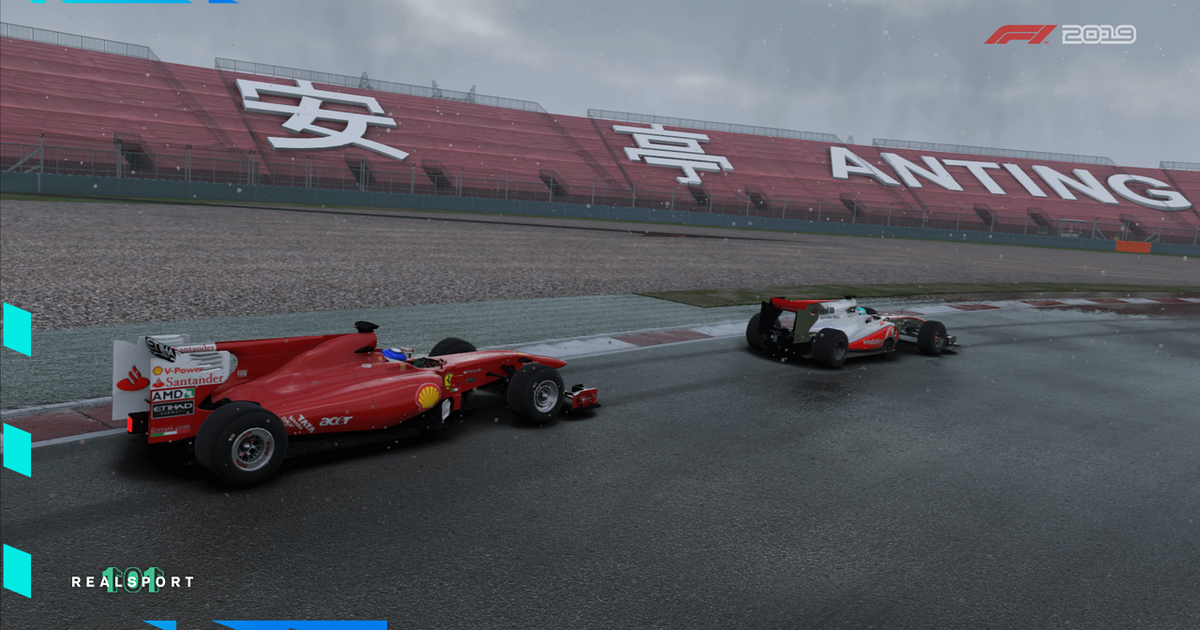The Chinese Grand Prix has quickly become one of the more entertaining races on the F1 calendar thanks to its high tyre wear, multiple overtaking points, and occasional wet weather.
When the rain hits in Shanghai it can come quickly and ruin your weekend. The nature of the circuit makes a tailored dry setup nearly impossible to use in the wet, so having a reliable backup plan is vital otherwise you'll be spinning off on every corner.
This is our wet race setup for the Chinese Grand Prix.
Table of Contents
READ MORE: All F1 2019 setup guides
Aerodynamics
Our wing angles are drastically different from the dry setup, which highlights just how different this track becomes once it rains. The wing angles of 3-10 keeps us pretty competitive down the straights and ultra-stable through the long corners that make this track deadly for the impatient when it rains.
READ MORE: How to control tyre wear
Transmission
As with most of our wet setups, we are using the transmission to provide predictable traction and acceleration out of corners, making the whole setup more consistent and driveable. The on-throttle differential is fully unlocked at 50% so that the rears can rotate more freely, allowing us to get on the power more comfortably, especially with one wheel on a kerb.
The off-throttle differential is set to 65%, the more locked nature of this setting means the rears are rotating more in sync when you are on the brakes, which again provides stability when you get on the power.
Suspension Geometry
The suspension geometry settings describe how the tyres are aligned to the body of the car. As the wet tyres are long wearing and the lower cornering speeds protect them anyway we can extract some performance from the rubber with these settings.
The camber setting is -2.60 on the front and -1.10 on the rear, this increases cornering performance. Front toe is set to 0.08 to give us a little more bite on turn-in, especially useful for the overtaking points of turn 6 and the hairpin after the back straight. Rear toe is set to 0.41 to improve rear stability once more.
READ MORE: Everything you need to know about Need For Speed: Heat
Suspension
The suspension settings are vital to the overall stability and predictability of the car. We have gone with the softest possible suspension at a 1-1 setting. This allows you to rid bumps and kerbs more effectively, vital if you want to maximise corner angle at some of the tighter spots on this track.
Anti-roll bars are set to 5-8. This keeps the rear in-line more, making it less likely to step out on you when you get your foot down through the long 270-degree right handers. This is vital for turn 12/13 that opens out onto the long back straight.
Ride height is set to 3-7. This creates a big rake that generates oversteer and turn-in bite, but it also keeps the car competitive down the straight as the rear end has plenty of room to compress as we have a high rear wing.
READ MORE: Wreckfest: A beautiful world of chaos awaits
Brakes
We have set the brake pressure to 80%. This provides enough stopping power to defend and attack into the hairpin while also being delicate enough to squeeze the brakes when we need to in the tightening turn 1/2 and the tricky esses of 7/8.
Brake bias is set to 54%, which keeps the front responsive while braking. This can be moved forward to create extra stopping power when you need it during the race.
READ MORE: WRC 8's career mode could be better than F1 2019
Tyres
Tyre pressure directly impacts wear and temperatures. As we have lifted some performance from the rubber with our camber settings we want to control wear so we have taken the tyre pressures right down to 21.0 psi & 19.5 psi. This has the added bonus of creating better traction out of corners, which is vital in the wet.
READ MORE: Pacer: Wipeout meets F-Zero for a new generation
So that's our setup for a wet race in China. The Shanghai circuit is a joy in the dry but turns very tricky in the wet. Your racing line will change and some of the corners become real challenges to balance front-end responsiveness and back end stability. That is what we have tried to do with this setup. The car shouldn't be trying to swap ends on you, unless you are overly aggressive, and it can ride some of the harsher kerbs too.
Explore new topics and discover content that's right for you!





